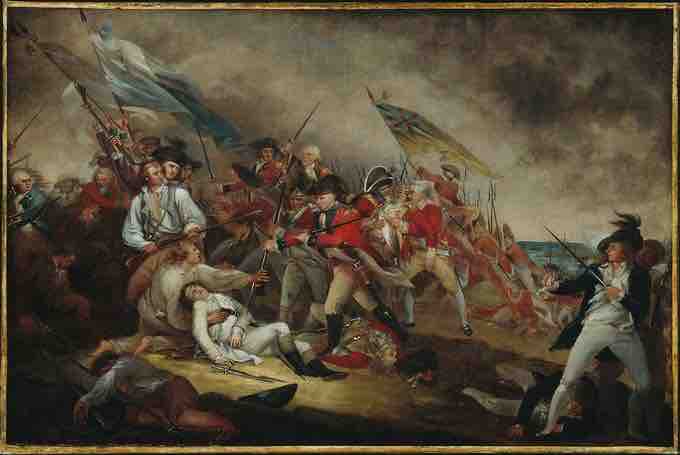Overview
The Battle of Bunker Hill took place on June 17, 1775, following the Battles of Lexington and Concord. By this time, Parliament had declared Massachusetts in a state of rebellion. The Battle of Bunker Hill took place mostly on and around Breed's Hill during the Siege of Boston early in the American Revolutionary War. The battle is named after the adjacent Bunker Hill, which was the original objective of both colonial and British troops.
The Battle
On June 13, 1775, the leaders of the colonial forces besieging British-occupied Boston learned that the British generals were planning to send troops out from the city to the surrounding unoccupied hills. In response to this intelligence, 1,200 colonial troops under the command of William Prescott stealthily occupied Bunker Hill and Breed's Hill. They constructed an earthen redoubt on Breed's Hill and built lightly fortified lines across most of the Charlestown Peninsula.
When the British were alerted to the presence of the new position the next day, they mounted an attack against them. After two assaults on the colonial lines, the colonial lines ran out of ammunition and the British finally captured the positions on the third assault. The colonial forces retreated to Cambridge over Bunker Hill, suffering their most significant losses on Bunker Hill itself.
While the result was a victory for the British, they suffered heavy losses—over 200 were killed and 800 wounded. The battle is seen as an example of a Pyrrhic victory because the immediate gain (the capture of Bunker Hill) was modest and did not significantly change the state of the siege, while the cost (the loss of nearly a third of the deployed British forces) was high. Meanwhile, colonial forces were able to retreat and regroup in good order having suffered few casualties. Furthermore, the battle demonstrated that relatively inexperienced colonial forces were willing and able to stand up to regular army troops in a pitched battle.
British Doubt and the Dismissal of Gage
When news of the battle spread through the colonies, it was reported as a colonial loss as the ground had been taken by the enemy and significant casualties were incurred. George Washington, who was on his way to Boston as the new commander of the Continental Army, received news of the battle while in New York City. The report, which included casualty figures that were somewhat inaccurate, gave Washington hope that his army might prevail in the conflict.
The Massachusetts Committee of Safety, seeking to repeat the sort of propaganda victory it won following the battles at Lexington and Concord, commissioned a report of the battle to send to England. Their report, however, did not reach England before British Lieutenant General Gage's official account arrived on July 20. The casualty counts alarmed the military establishment in England and forced many to rethink their views of colonial military capability. King George's attitude toward the colonies hardened, and the news may have contributed to his rejection of the Continental Congress' Olive Branch Petition, the last substantive political attempt at reconciliation. This hardening of the British position in return led to a strengthening of previously weak colonial support for outright rebellion and independence, especially in the formerly uncertain southern colonies.
Gage's report had a more direct effect on his own career. His dismissal from office was decided just three days after his report was received, although General Howe did not replace him until October of 1775. Gage wrote another report to the British Cabinet in which he repeated earlier warnings that "a large army must at length be employed to reduce these people" that would require "the hiring of foreign troops."

The Battle of Bunker Hill by John Trumball
This painting illustrates the death of General Warren at the Battle of Bunker Hill.